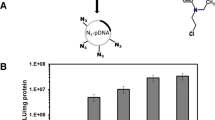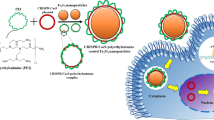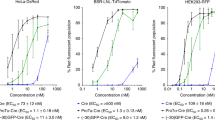Abstract
This protocol provides a method for synthesizing a biocleavable polyrotaxane/plasmid DNA (pDNA) polyplex and for using it to deliver pDNA into cell nuclei. The biocleavable polyrotaxane is synthesized in four steps: (i) introduction of disulfide linkages at both terminals of PEG, (ii) preparation of an inclusion complex between disulfide-containing PEG and α-cyclodextrins (α-CDs), (iii) synthesis of polyrotaxane and (iv) modification of α-CDs in the polyrotaxane with dimethylethylenediamine. A polyplex of pDNA with the polyrotaxane is formed when the two compounds are dissolved together in a phosphate buffer. Subcellular localization of rhodamine-labeled pDNA in fluorescently labeled organelles is quantified by Z-series of confocal images captured by confocal laser scanning microscopy. Significant amounts of pDNA delivered to the nucleus can be expected as well as high transfection activity of the polyplex. This protocol can be completed in 23–32 d.
This is a preview of subscription content, access via your institution
Access options
Subscribe to this journal
Receive 12 print issues and online access
$259.00 per year
only $21.58 per issue
Buy this article
- Purchase on Springer Link
- Instant access to full article PDF
Prices may be subject to local taxes which are calculated during checkout









Similar content being viewed by others
References
Luo, D. & Saltzman, W.M. Synthetic DNA delivery systems. Nat. Biotechnol. 18, 33–37 (2000).
Wolff, J.A. The 'grand' problem of synthetic delivery. Nat. Biotechnol. 20, 768–769 (2002).
Godbey, W.T., Wu, K.K. & Mikos, A.G. Poly(ethylenimine) and its role in gene delivery. J. Control. Rel. 60, 149–160 (1999).
Kunath, K. et al. Low-molecular-weight polyethyleneimine as a nonviral vector for DNA delivery: comparison of the psysicochemical properties, transfection efficiency and in vivo distribution with high-molecular-weight polyethyleneimine. J. Control. Rel. 89, 113–125 (2003).
Read, M.L. et al. Vectors based on reducible polycations facilitate intracellular release of nucleic acids. J. Gene Med. 5, 232–245 (2003).
Miyata, K. et al. Block catiomer polyplexes with regulated densities of charge and disulfide cross-linking directed to enhance gene expression. J. Am. Chem. Soc. 126, 2355–2361 (2004).
Ooya, T. et al. Biocleavable polyrotaxane-plasmid DNA polyplex for enhanced gene delivery. J. Am. Chem. Soc. 128, 3852–3853 (2006).
Akita, H., Ito, R., Khalil, I.A., Futaki, S. & Harashima, H. Quantitative three-dimentional analysis of the intracellular trafficking of plasmid DNA transfected by a nonviral gene delivery system using confocal laser scanning microscopy. Mol. Ther. 9, 443–451 (2004).
Hama, S. et al. Quantitative comparison of intracellular trafficking and nuclear transcription between adenoviral and lipoplex systems. Mol. Ther. 13, 786–794 (2006).
Ichi, T., Watanabe, J., Ooya, T. & Yui, N. Controllable erosion time and profile in poly(ethylene glycol) hydrogels by supramolecular structure of hydrolysable polyrotaxane. Biomacromolecules 2, 204–210 (2001).
Acknowledgements
The authors acknowledge Dr. H.S. Choi, A. Yoshihiro, Y. Sugaya and R. Ito for their help in a portion of the experiments.
Author information
Authors and Affiliations
Contributions
N.Y., A.M. and H.H. contributed equally to this work.
Corresponding author
Ethics declarations
Competing interests
The authors declare no competing financial interests.
Rights and permissions
About this article
Cite this article
Yamashita, A., Yui, N., Ooya, T. et al. Synthesis of a biocleavable polyrotaxane-plasmid DNA (pDNA) polyplex and its use for the rapid nonviral delivery of pDNA to cell nuclei. Nat Protoc 1, 2861–2869 (2006). https://doi.org/10.1038/nprot.2006.438
Published:
Issue Date:
DOI: https://doi.org/10.1038/nprot.2006.438
This article is cited by
-
Lysosomal-specific Cholesterol Reduction by Biocleavable Polyrotaxanes for Ameliorating Niemann-Pick Type C Disease
Scientific Reports (2014)
-
Recycling Gene Carrier with High Efficiency and Low Toxicity Mediated by L-Cystine-Bridged Bis(β-cyclodextrin)s
Scientific Reports (2014)
-
Molecular logistics using cytocleavable polyrotaxanes for the reactivation of enzymes delivered in living cells
Scientific Reports (2013)
-
Polyrotaxanes for applications in life science and biotechnology
Applied Microbiology and Biotechnology (2011)
Comments
By submitting a comment you agree to abide by our Terms and Community Guidelines. If you find something abusive or that does not comply with our terms or guidelines please flag it as inappropriate.



